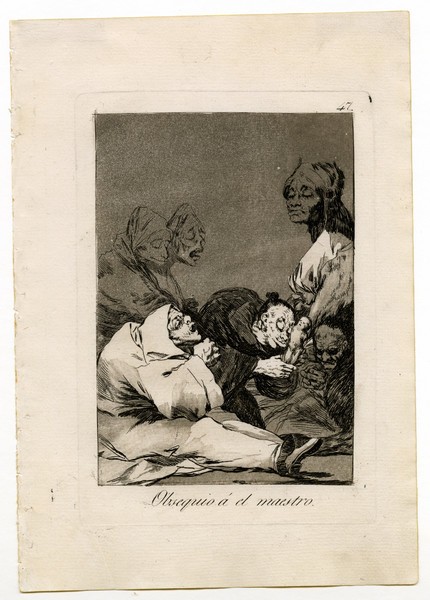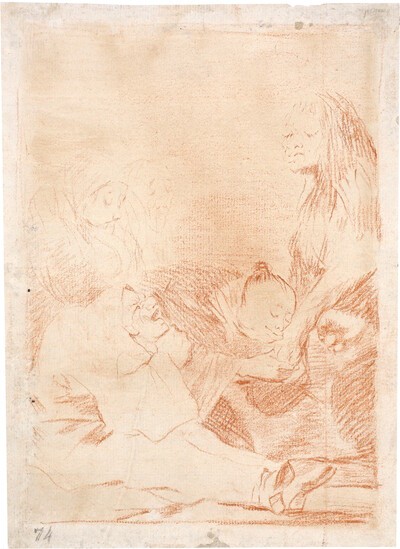- Cronología
- Ca. 1797 - 1799
- Dimensiones
- 208 x 153 mm
- Técnica y soporte
- Etching and burnished aquatint
- Reconocimiento de la autoría de Goya
- Undisputed work
- Ficha: realización/revisión
- 19 Dec 2010 / 29 May 2024
- Inventario
- 225
Obsequio á el maestro. (at the bottom)
47. (in the upper right-hand corner)
See Francisco de Goya y Lucientes, Painter.
A preparatory drawing of this engraving is in the Prado Museum.
A group of sinister figures pay obeisance to a figure on the right-hand side of the engraving. The figure gazes down at the figure and, although his head is human, his body is that of a billy goat and is covered with hair. The sinister witches who worship him have aged and deformed faces and have brought him a human foetus as a gift. It is a coven, which is the Basque term for the places where witches held their meetings and performed their rituals.
Goya has only applied an intermediate tone of aquatint over the etching in this print. The whites of the chest of the great witch, the face of the witch carrying the foetus and the figure in the foreground contrast with the darkness of the rest of the print.
The explanations provided by the manuscripts indicate that this is a group of nuns and friars expressing their gratitude to the master who has taught them what they know.
The painter unequivocally criticised superstition and acts of witchcraft, as he did in the paintings for the Duke and Duchess of Osuna, which may predate the Caprices series slightly. This theme would continue to interest him throughout his career, when he would return to it with different, perhaps more extreme, expressive mechanisms.
The plate is in rather poor condition ( National Chalcography, no. 218).
-
Goya. Gemälde Zeichnungen. Graphik. TapisserienKunsthalle BaselBasle1953from January 23th to April 12th 1953cat. 234
-
Goya. La década de Los CaprichosMadrid1992organized by Real Academia de Bellas Artes de San Fernando sponsored by Fundación Central Hispano, Madrid, consultant editor Nigel Glendinnig. From October 26th 1992 to January 10th 1993cat. 112
-
Francisco de GoyaMuseo d'Arte ModernaLugano1996exhibition celebrated from September 22nd to November 17th.cat. 47, p.74
-
Francisco Goya. Sein leben im spiegel der graphik. Fuendetodos 1746-1828 Bordeaux. 1746-1996Galerie KornfeldBern1996from November 21st 1996 to January 1997cat. 53
-
Goya e la tradizione italianaFondazione Magnani RoccaMamiano di Traversetolo (Parma)2006consultant editors Fred Licht and Simona Tosini Pizzetti. From September 9th to December 3th 2006cat. 47, p.157
-
Goya. Opera graficaPinacoteca del Castello di San GiorgioLegnano2006exhibition celebrated from December 16th 2006 to April 1st 2007p.36
-
Goya e ItaliaMuseo de ZaragozaZaragoza2008organized by the Fundación Goya en Aragóna, consultant editor Joan Sureda Pons. From June 1st to September 15th 2008cat. 331
-
Goya et la modernitéPinacothèque de ParisParís2013from October 11st 2013 to March 16th 2014cat. 147
-
2022
-
Goya engravings and lithographs, vol. I y II.OxfordBruno Cassirer1964p.122, cat. 84
-
Vie et ouvre de Francisco de GoyaParísOffice du livre1970p.182, cat. 545
-
El gran cabrón del aquelarre en GoyaBoletín del Museo e Instituto "Camón Aznar"ZaragozaIbercaja1981pp.23-37
-
Goya, la década de los caprichos: dibujos y aguafuertesMadridReal Academia de Bellas Artes de San Fernando1992pp.190-191, cat. 112
-
Goya. El capricho y la invención. Cuadros de gabinete, bocetos y miniaturasMadridMuseo del Prado1993pp.213-214, fig. 154
-
Catálogo de las estampas de Goya en la Biblioteca NacionalMadridMinisterio de Educación y Cultura, Biblioteca Nacional1996p.98, cat. 136
-
El libro de los caprichos: dos siglos de interpretaciones (1799-1999). Catálogo de los dibujos, pruebas de estado, láminas de cobre y estampas de la primera ediciónMadridMuseo Nacional del Prado1999pp.258-261
-
ParísPinacoteca de París2013p. 209
-
Goya. In the Norton Simon MuseumPasadenaNorton Simon Museum2016pp. 42-75
-
Museo de Bellas Artes de Badajoz y Diputación de Badajoz2022p. 43

